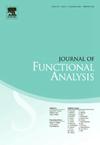Random geometric graphs in reflexive Banach spaces
IF 1.6
2区 数学
Q1 MATHEMATICS
引用次数: 0
Abstract
We investigate a random geometric graph model introduced by Bonato and Janssen. The vertices are the points of a countable dense set S in a (necessarily separable) normed vector space X, and each pair of points are joined independently with some fixed probability p (with ) if they are less than distance 1 apart. A countable dense set S in a normed space is Rado, if the resulting graph is almost surely unique up to isomorphism: that is any two such graphs are, almost surely, isomorphic.
Not surprisingly, understanding which sets are Rado is closely related to the geometry of the underlying normed space. It turns out that a key question is in which spaces must step-isometries (maps that preserve the integer parts of distances) on dense subsets necessarily be isometries. We answer this question for a large class of Banach spaces including all strictly convex reflexive spaces. In the process we prove results on the interplay between the norm topology and weak topology that may be of independent interest.
As a consequence of these Banach space results we show that almost all countable dense sets in strictly convex reflexive spaces are strongly non-Rado (that is, any two graphs are almost surely non-isomorphic). However, we show that there do exist Rado sets even in . Finally we construct a Banach space in which all countable dense set are strongly non-Rado.
自反Banach空间中的随机几何图
研究了Bonato和Janssen引入的随机几何图模型。这些顶点是(必然可分的)赋范向量空间X中可数密集集合S中的点,如果它们之间的距离小于1,则每对点以一定的固定概率p (0<p<1)独立连接。赋范空间中的可数密集集S是Rado,如果结果图几乎肯定是唯一的,直到同构:即任何两个这样的图几乎肯定是同构的。毫不奇怪,理解哪些集合是Rado与底层赋范空间的几何结构密切相关。一个关键的问题是,密集子集上的步进等距(保留距离整数部分的映射)在哪些空间中必然是等距。我们对包含所有严格凸自反空间的一大类巴拿赫空间回答了这个问题。在此过程中,我们证明了一些有独立意义的关于规范拓扑和弱拓扑相互作用的结果。作为这些Banach空间结果的结果,我们证明了严格凸自反空间中几乎所有可数稠密集都是强非rado的(即,任意两个图几乎肯定是非同构的)。然而,我们证明了即使在l2中也存在Rado集。最后构造了一个Banach空间,其中所有可数稠密集都是强非rado的。
本文章由计算机程序翻译,如有差异,请以英文原文为准。
求助全文
约1分钟内获得全文
求助全文
来源期刊
CiteScore
3.20
自引率
5.90%
发文量
271
审稿时长
7.5 months
期刊介绍:
The Journal of Functional Analysis presents original research papers in all scientific disciplines in which modern functional analysis plays a basic role. Articles by scientists in a variety of interdisciplinary areas are published.
Research Areas Include:
• Significant applications of functional analysis, including those to other areas of mathematics
• New developments in functional analysis
• Contributions to important problems in and challenges to functional analysis

 求助内容:
求助内容: 应助结果提醒方式:
应助结果提醒方式:


